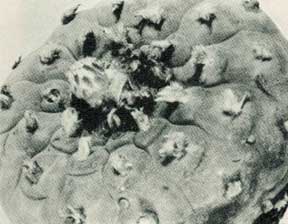Peyote and the American Indian
By RICHARD EVANS SCHULTES
Nature Magazine, September 1937
When the Spaniards came to Mexico, they found, among other sacred plants, a small, narcotic cactus that was worshipped by the natives. In spite of four centuries of civil and religious opposition, the worship of this "divine" plant-peyote-has not died out in Mexico. Moreover, circumstances attendant upon the spread of white man's culture throughout North America have made it possible for the peyote-religion of Mexico to diffuse, in a modified form, to more than thirty Indian tribes of the United States.
Peyote, Lophophora williamsii, the central figure in this "new" Indian religion, is a small, grayish green, spineless cactus. It is found growing on both banks of the Rio Grande and in Mexico as far south as Hidalgo. It is rather insignificant in appearance; the greater part of the plant consists of the root. Its small, globular crown is divided into from seven to thirteen ribs, straight or spiraled, on which are borne areoles with tufts of silky hair. The pink flower opens in a depression in the top of the crown.

PEYOTE IS A CACTUS
The crowns, cut off and dried, form small discs called "mescal buttons". It is in this form that the narcotic is eaten for the intoxication that results. Peyote contains from four to seven remarkable alkaloids, one of which is capable of causing colored hallucinations. With eyes closed, the fortunate worshipper may, for hours, enjoy a kaleidoscopic play of the most indescribably beautiful visions of geometric figures and familiar things on a background of constantly changing colors, so exquisitely rich as to seem supernatural.
It is easy to understand, then, how such a powerful plant could be regarded as a "messenger" capable of putting the individual in communication with the gods without the medium of a priest, for peyote is believed to perform such a function by members of the cult. The Huichol of Mexico consider peyote the incarnation of a god; the Tarahumare hold that when Father Sun left earth to dwell above, he put peyote here to cure man-kind's ills. "Hikuli (peyote) is not as great as Father Sun, but sits next to him."
Havelock Ellis gives the following description of the visions that came to him while under the influence of peyote: "Every color and tone conceivable to me appeared at some time or another... At first there was merely a vague play of light and shade which suggested pictures, but never made them. Then the pictures became more definite, but too confused and crowded to be described, beyond saying that they were of the same general character as the images of the kaleidoscope: symmetrical groupings of spiked objects. Then, in the course of the evening, they became distinct, but still indescribable-mostly a vast field of golden jewels, studded with red and green stones, ever changing. At the same time, the air around me seemed to be flushed with vague perfume, producing with the visions a delicious effect and all discomfort had vanished, except a slight faintness and tremor of the hands, which, later on, made it almost impossible to guide a pen as I made notes of the experiment; it was, however, with an effort, always possible to write with a pencil."
 Printer-friendly version
Printer-friendly version
